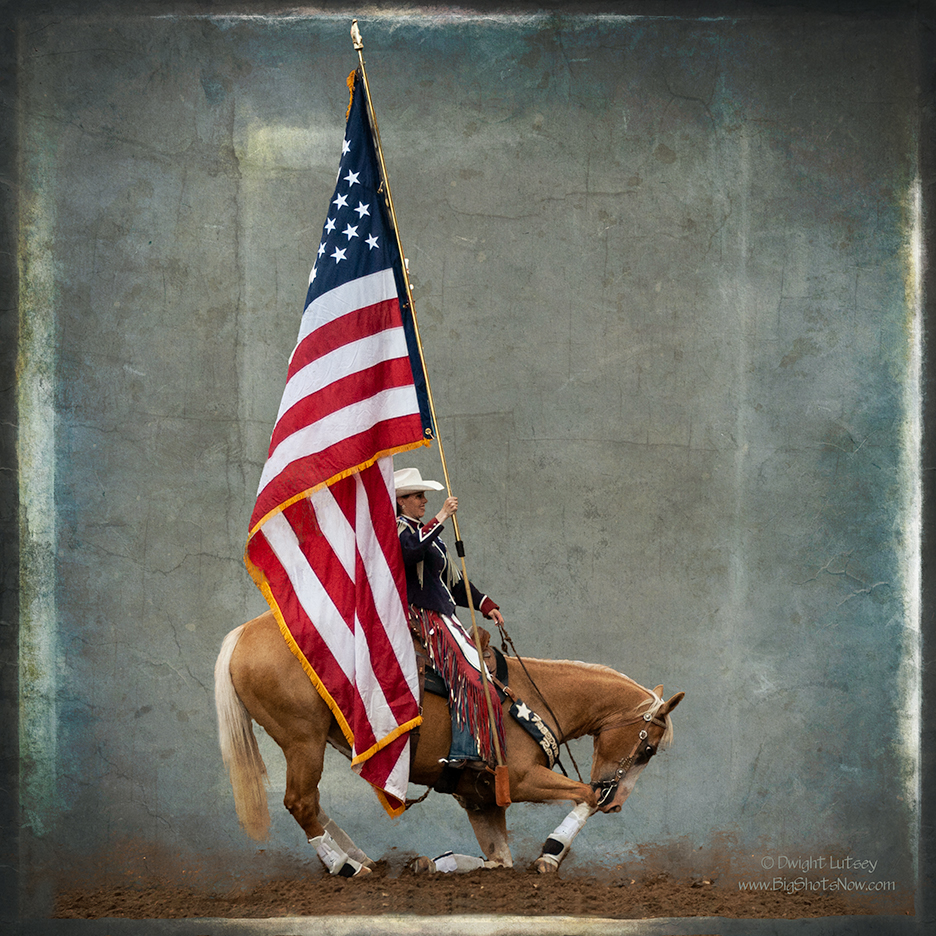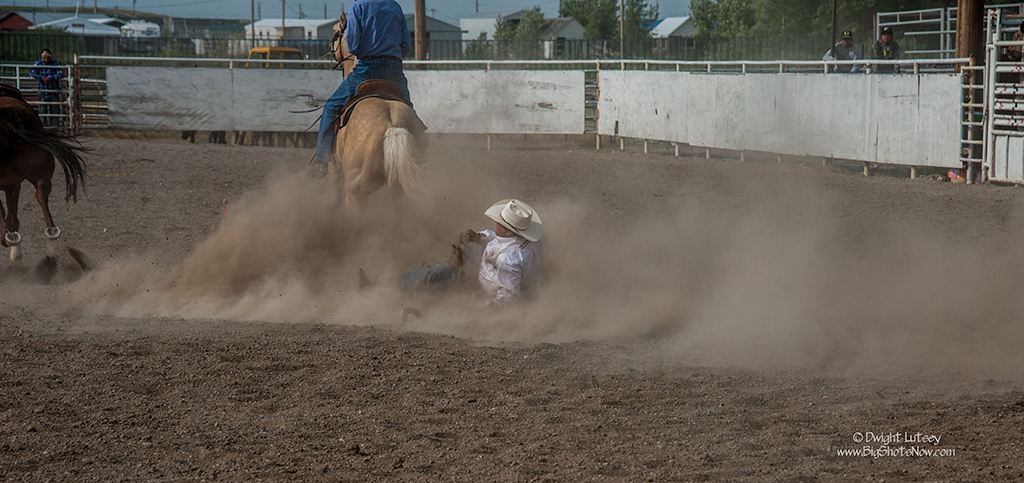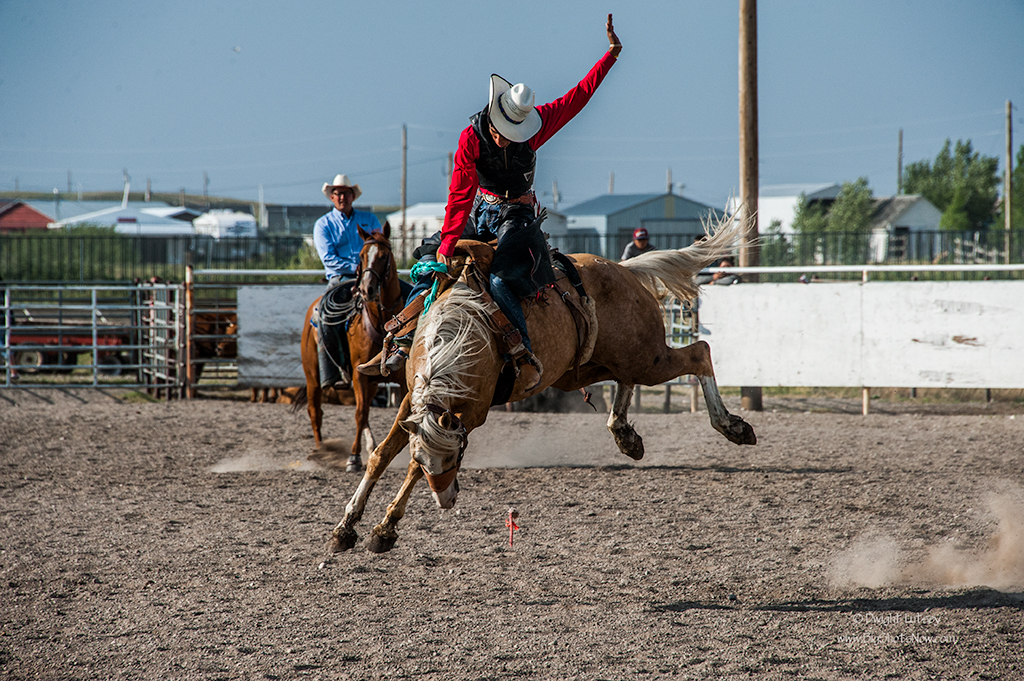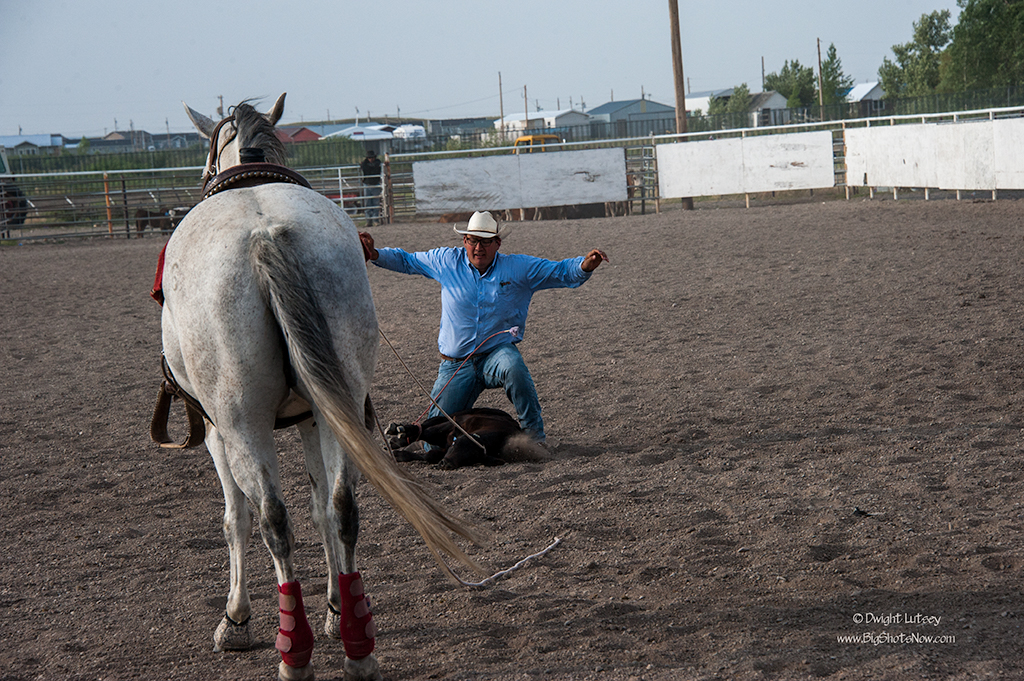
For All Those Who Served
We Salute You
And Thank You

This post has been moved to OpenChutes.com. All future postings of Powwows, Indian Relay Races, Rodeos and Rendezvous will be posted there from now on exclusively. So if you’re looking for new images and posts for all those events attended this year, plus all the old posts posted on BigShotsNow.com check out OpenChutes.com. See you there!
Camp life at the Crow Fair is filled with opposites. Some times the camp is a wash of chaotic activity as everyone gets ready to attend the dance ceremonies or the parades and other times, like this morning, which happened to be a Sunday morning, everything was calm and serene.
Walking through the camp in the early morning just after sunup everything is still. There are no motor sounds yet from vehicles, or people calling from one area to another. It is quiet. The only sounds you hear are the horses gently calling to each other and the quiet sounds of camp life where people are just stirring, thinking about getting breakfast going, standing out by their lodges seeing what kind of day it is going to be. It is a good time to see the camp.
Horses are feeding, taking advantage of this quiet time. Soon enough they’ll be as excited as anyone else in the camp to be getting ready to attend the various activities.
The teepees are clustered closely together which usually means a large family group are all settled in next to one another.
Many groups fly the American flag above their camp.
A horse is waiting for someone to come and take him the river for a long drink. He’s just heard some other horses go by as early risers get a start on the day.
This is 2015 not 1876 and the rides are different for some of the people. It’s likely there is a horse tucked away somewhere but there is also a new breed of horse, a mechanized one, and it seems fitting to see it tied up in front of the lodge.
It’s unsure whether these folks that occupy this lodge are coming or going as it looks vacant. The topping to go on the arbor isn’t all in place up on the roof yet, so we’re betting on their coming.
Horses resting up for the day to come. Their owners lodge is just visible up over the hill.
There are many of these wall tents in the camp. Someone told me they serve as overflow if the teepees are overcrowded. He also told me he’d rather be in a teepee as the tents were too hot. The opening at the top of the teepees can be adjusted to let the hot air out so they were cooler to be in. After 100+ degree days any thing that would offer coolness was in high demand.
Placed against the tree line for shade and to block any wind this is a well placed group of lodges.
These riders are taking their horses down to the river for a drink. It’s also a good time to talk about whatever young women talk about.
The doors of the lodges are all facing the trees. you can see extra lodge poles leaning against the tree line.
There were some teepees that were decorated or painted but the majority were of white weathered canvas.
One evening after the dances ended very late, it seems that my vehicle misplaced itself and I wandered for several hours through the maze of teepees trying to find it. By about 1:30 in the morning I had found all 1200 of the tepees but not my Jeep. Of course never having been lost before in my life I neglected to bring a flashlight and since there is a major absence of street lights in a Crow camp, finding ones way about was difficult. Fortunately I learned an old Indian trick that night and turned on my flashlight app on my cell phone and eventually I found this red striped teepee that I remembered seeing on the way in and shortly after found the Jeep. There are always adventures on these trips, some big, some little. This was a little one even though it didn’t feel that way as it was happening.
There were some teepees whose decoration had an unmistakable meaning
Horses picketed amongst the lodges was an amazing sight to see. The mix of old ways and new was constantly presented to the observer.
The patina on these lodges indicated that they had seen plenty of use. The ivory color was perfect for the setting.
It’s getting a little later in the morning now and this horse was definitely interested in going to the river. Shortly after this picture was taken he got his wish.
This is the Little Bighorn river as it wends its way through the camp. It’s quite shallow here so it’s easy to ride the horses down to the edge.
Some of the horses were eager to wade out in the water where it was slightly deeper, others preferred to drink at the bank.
Boys bringing ponies down to get their drink. There was no horse-play here, pardon the pun, as these guys proceeded to get the stock watered. No rock throwing or goofing around, they got the job done well and were soon on their way back to camp.
A teepee set up along the river. They had shade all day and you could hear the river running by as well. A bonus for picking a great spot.
An overview of a small portion of the camp from a little ridge that ran along the back of the camp.
While out on the edge of the camp and looking towards the plains a flock of Prairie chickens passed by going swiftly over the exposed hilltop to the safety of the ravine on the other side.
This is a panorama made up of 25 pictures stitched together to try and show the size of the camp. If the picture were printed out it would be over 8′ long. Consequently to compress it down to this size so it would fit on to the page of the blog, details are very small indeed. If you click on it to see the slightly larger version you can see a little more. But as it was only intended to give you a sense of scale and an overview of just how large the encampment is, hopefully it does that, even if you can’t make out who it is sitting in front of that back teepee is.
It is a good feeling to see that many lodges together and the people that fill them living together in harmony. When you think that there might be an average of four people to a lodge that is 4800 people. That’s a small town any where you want one.. What a great experience to have, to be able to see and take part in this get together. Crow Fair 2015.
This post has been moved to OpenChutes.com. All future postings of Powwows, Indian Relay Races, Rodeos and Rendezvous will be posted there from now on exclusively. So if you’re looking for new images and posts for all those events attended this year, plus all the old posts posted on BigShotsNow.com check out OpenChutes.com. See you there!
The North American Indian Days is an annual event held on the Blackfeet Indian reservation usually in July and is billed as one of the biggest tribal get-togethers in North America. They say North American instead of the Unites States because some of the participants are from tribes that live in Canada. It lasts for about a week, four days according to the advertisements, but everybody’s there early and leaves late so plan on at least five or six days if you want the full experience.
Rodeo plays a huge part in the festivities at the North American Indian Days. There are events for everyone and they provide a chance for the contestants to show off their skills in front of an audience of their peers. Winning a pot full of money for being the best in their event doesn’t hurt either. There are numerous events and many contestants in each one so we’re going to present an overview of the rodeo. Some of the highlights of each event and some of the atmosphere that makes going to the Rodeo such an exciting experience. In the shot above you see that everyone doesn’t walk away a winner. At least not this time. But there’s always the next event and the outcome can be completely different. This is a longer post than usual because there is so much to take in. Read it at your leisure or just look at the pictures. Both work. As always click on an image to see a larger version.
As in all events the rodeo is opened with presenting the flag and paying tribute to our great country. Because there were such a large number of Indian participants and visitors present from Canada they proudly displayed their flag with ours.
The first event was Barrel riding where the rider enters the ring and rides a pattern around three barrels. The horse and rider have to act as one and you can see the effort and concentration by both in this shot.
Rodeo is a family sport. Each member has an event they participate in. Here a dad is showing his son how to do it. The youngster is only three years old. Rodeo starts early.
Whenever you deal with steers or bulls you are tempting the fates. The rodeo actually started in the chute before the door got opened and consequently the participants both human and animal, tumbled out into the arena. This is not an opportune way to begin your ride.
Here the bull had divested itself of its rider and was celebrating. In speaking with the rodeo clown later he was asked what his plan was in running in under the bull like that. His reply was that he thought he could catch the bulls hind legs while they were in the air and hold him up while he wheelbarrowed him over to the catch pen. Unfortunately that did not work out. The clown is still alive though and already working up new ideas for the next event.
In the team roping event the plan is for one roper called a header to get a rope around the calf’s head and the other roper called a heeler to get one around the calves back legs thereby immobilizing the calf so it could be branded. This time the heeler or back leg catcher got his rope around only one leg instead of both. Still counts but with a ten second penalty added to their score.
This event is called the Tie down or break away event. The end of the rope used to catch the calf is tied to the saddle horn with a piece of string and the rider ropes the calf. The horse immediately stops and when the calf runs out far enough it breaks the string and time is called. Fast, fun event.
Here we see “How to Catch a Cowboy”. The trick is to convince the cowboy to hop like a rabbit, while the cowgirl acts as a heeler and ropes his feet while he’s in the air. When she catches him, he’s quickly hog-tied and, well, caught. What happens from that point on was not displayed. This was not an official sanctioned event, but we were told it goes on all the time.
Bareback bronc riding is the event that started rodeo. Everything else evolved from this event. It’s pretty simple, you climb on the horses back and ride. He tries to throw you off. Eight seconds pass and if you’re still on the horses back you wins. If not, there’s always next time.
The horse will attempt all manner of things to dislodge the rider. He’s a coiled spring ready to explode.
Steer wrestling is when a big cowboy deliberately jumps off his horse to catch a steer and wrestle it to the ground. This event always looks like a mistake that grew into a huge exciting event. It’s serious though and one of the more dangerous interpersonal contact sports there is in rodeo.
However when it goes wrong, like here when the calf went another way just as the cowboy leapt from his speeding horse to bulldog it, you see that it terribly unforgiving of any error.
Besides losing your horse, the face plant in the dirt and the resulting mouthful of arena soil just adds insult to injury.
 The amazing thing and the proof that you are watching truly exceptional cowboys is he never lost his hat.
The amazing thing and the proof that you are watching truly exceptional cowboys is he never lost his hat.
The storyteller. All around the arena you will find spectators sitting on the fence watching the action and talking. And as it has always been there is one that can mesmerize his fellows with stories of amazing adventure and incredible action. HIs rapt audience hangs on every word. This is one of those storytellers.
 Saddle bronc riding is just like bareback riding except you use a saddle. Still just as exciting.
Saddle bronc riding is just like bareback riding except you use a saddle. Still just as exciting.
These are the pickup men. They’re out in the arena to catch the cowboy off the back of bucking horses after the ride is over, catch and return the riderless horses to the catch pen, and generally do the work that needs to be done to keep the events moving steadily through the rodeo. It’s not a simple task and there is often a lot of action right up against the fence as things unfold. Besides the rodeo clowns these men are the unsung heroes of the rodeo.
They are also the ones that handle the unruly bulls and other bucking stock. They need to be experienced, unflappable men and they are.
Here’s another event straight out of the history books of ranch work. The calf roping. A calf is released, the cowboys chases it down, ropes it and he gets off his horse while it backs up holding the calf steady.
 He quickly reaches the calf, ties all four feet together immobilizing it so it can be branded.
He quickly reaches the calf, ties all four feet together immobilizing it so it can be branded.
 As soon as he’s finished you see his arms come up and time is called. The cowboy and horse work as a team and the better the teamwork the shorter the time.
As soon as he’s finished you see his arms come up and time is called. The cowboy and horse work as a team and the better the teamwork the shorter the time.
Normally the last event on the schedule is bull riding. It’s last because it is the most exciting and the one everyone wants to see. This is the event that puts the show business in rodeo. There is very little need for a bull to be ridden in normal ranch work. You’re not going to break them to ride, or to pull a buggy to town. When a cowboy crawls on the back of a bull it for one reason and one reason only. To see if he can do it, can he ride this monster beast for eight seconds without getting killed or maimed. It is a test of courage. And people love to see it.
Many times the whole event is over before the bull clears the chute. But even if the event lasts for only a second or two it is packed to the brim with unbridled excitement. Enough so that entire events are held showcasing bull riding only. Lots of Ace bandages and liniment are sold at these events.
The rodeo is held several nights during the North American Indian days and it’s a new show every night. It’s an experience you won’t soon forget.
This post has been moved to OpenChutes.com. All future postings of Powwows, Indian Relay Races, Rodeos and Rendezvous will be posted there from now on exclusively. So if you’re looking for new images and posts for all those events attended this year, plus all the old posts posted on BigShotsNow.com check out OpenChutes.com. See you there!
Last week, July 9th thru the 12th, The Blackfeet tribe put on its 64th annual North American Indian days (or NAID) on its reservation at Browning, Montana. It was 4 solid days of Dancing, singing, fellowship, and socializing amongst one of the largest gathering of Indian tribes in the United States and Canada.
Every event held throughout the celebration began with the Grand Entrance where the color guard, made up of military veterans from the various tribes, brought in the colors. These included our American flag, Canada’s flag, the Blackfeet tribe’s flag, and others to be presented with respect to everyone assembled. Many men and women of the tribes served in the armed forces and this is a very important part of the ceremony. To participate in this honor, with drums sounding out their deep resonance, singers celebrating with their voices, joining the gathering of hundreds of spectators, the sun beating down and the hot wind blowing through the presentation arbor, this is an experience that will remain with you for a very long time.
When you attend this event one of the first things you notice is the riot of color around you. The regalia, the decorations, the site itself is full of every hue of color imaginable, from the earth tones of the arbor and dancing area to the manmade colors of some regalia, and the natural shades of the surrounding area. The natural light of the far northern part of our country has its own unique look and feel also, and being just a little more than 12 miles from the eastern entrance to Glacier National Park adds to the overall effect with mountains in the background and of course amazing sunsets.
The sounds are the next thing you notice as the deep rhythmic notes of the many drums and songs work their way into your senses. Drums and drummers from many places around the country, the singers joining in, the sounds of the calls made by the various participants as they dance around the arbor, are nearly overwhelming. You are immersed in the experience completely. They draw you in and mesmerize you even if you don’t understand the words. It is easy to get lost in the sound and action and swirling colors, but that is part of the experience of being here. And it feels good.
Over the next few days we will be bringing you the sights of this incredible experience, the regalia , the dances, along with the other events such as the rodeos and Indian Relay Races, plus some of the views of the countryside around the events themselves. It was a spectacular experience. If you can, go to the next one, it is worth every second you spend there. The Blackfeet welcome all guests and you’ll never forget the time you spent at The North American Indian Days celebration.
You must be logged in to post a comment.